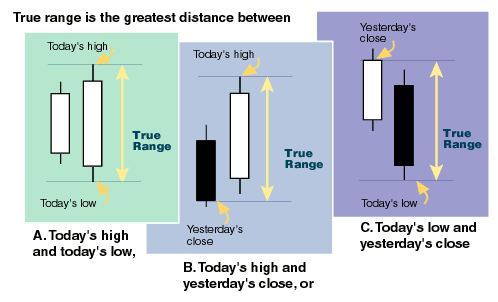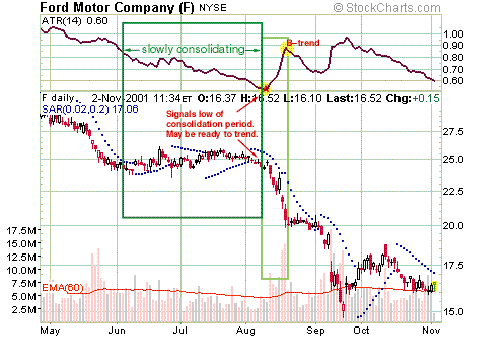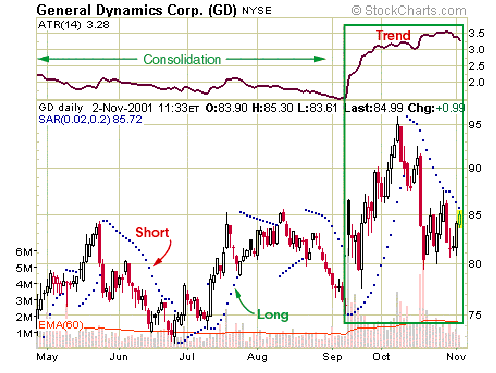
HOT TOPICS LIST
- Strategies
- Stocks
- Buy
- Investing
- Brokers
- Psychology
- Interviews
- Accumulate
- Sell
- Hold
- Spotlight
- Websites
- Candlestick Corner
- Gold & Metals
- Options Trading
LIST OF TOPICS
TRADER'S NOTEBOOK
Average True Range
12/11/01 02:15:26 PM PSTby Sharon Yamanaka
Average or extraordinary, "true range" is often referred to in stocks and commodities trading. But what is it?
| Trader, author, and technician J. Welles Wilder developed average true range (ATR) in the 1970s as a measurement of price volatility. Wilder believed that the range was directly proportional to volatility, and that range — the high and low of a stock for a given period, be it intraday, daily, weekly, or monthly — was indicative of a trend. If the volatility of a stock increased, it was entering a trend, and if it slowed down, it suggested a reversal. He further refined the trading range, calling it a true range when he included changes in price that occurred from the previous day's close rather than starting from the opening price. Such things as after-hours announcements that would predispose the market to open higher or lower next day would not be accounted for. The price range for the day would increase, and that difference, or higher volatility, would be included in the true range. For some stocks and commodities, during volatile times, this would be fairly significant. For example, a stock closing at $10, then opening the next day at $12, that traded between the opening $12 and $12.50, would only show a 0.5 range, whereas the stock had actually risen 2.5 points from the day before. There are three different scenarios you will encounter when calculating true range (Figure 1).
Figure 1: There are three possible scenarios when calculating true range.
ATR AS AN INDICATORAverage true range (ATR) is often used as an indicator, but is not one itself. It doesn't necessarily predict anything, but extremes in activity can indicate a change in a stock's movement; higher ATRs can mean a stock is trending, and lower ATRs could indicate a consolidation in price. Whether the stock is trending up or down, the range is always positive. This is because true range is calculated as an absolute value, meaning that the smaller price (opening or closing) will be subtracted from the larger, therefore always assuring a positive number. Figure 2 is Ford (F) with a low ATR and Figure 3 is General Dynamics (GD), the ATR of which is relatively higher. Note also the pre and postSeptember 11th trading patterns.
Figure 2: Ford Motor Co. (F) with ATR on the top, and the parabolic stop and reverse (SAR), Wilder's volatility indicator, shown as the dotted lines. As the stock begins to trend in mid-August, ATR shoots up from a low of 0.50 to almost 0.90 in a week's time. Note also there is a divergence — ATR is going up as the stock trends down.
Figure 3: General Dynamics Corp. (GD). With an ATR of 3.28, this stock is showing more volatility than Ford. If you want to place a stop on this stock, you should give it more leeway than a stop placed on Ford. Ford is trading at about a fourth of the dollar amount of GD ($22 versus $85), so multiplying the ATR of 16 by four would produce an ATR of 2.4, still much lower than GD's 3.28 mark.
J. Welles Wilder himself used ATR as the basis for his volatility system. Called parabolic stop and reverse (SAR) because of the rounded curve it produces, this trend-following system uses a trailing stop to generate its entry and exit signals. SAR is a common indicator and can be found on the larger charting websites such as BigCharts and StockCharts.com. Its attraction is that its initial stop is placed far away from the entry point and allows a certain amout of leeway for the trade to develop. Later, as the stock advances and becomes profitable, the stop is constantly recalculated so that it becomes tighter and tighter, allowing less volatility (and therefore loss) on a profitable trade. You can see how closely SAR hugs the stock price during the consolidation period between June and August in the chart of Ford, and how far away it gets when the stock is trending during October.
THE BIG GAPFigures 2 and 3 clearly show different trading patterns before and after the September 11th attacks. General Dynamics (Figure 3), an aerospace company with defense contracts, looks like a completely different stock once Wall Street started trading again on September 17. This is very apparent on the average true range. It goes from looking like a relief map of the Great Plains to the white cliffs of Dover. On its September 17th opening, GD gapped upward from its September 10th closing price of 75.97 to a high of 86.60. Later the stock lost ground, reaching a low of 80.77 and closing at 82.90. The true range for the day was 10.63, up from the 1.5 ATR prior to September 11. Ford (Figure 2) more conventionally gapped downward, following the overall market trend, hitting a new low, recovering, and then bouncing like a seismograph registering aftershocks, which is perhaps after all what really happened. Each reversal was shorter than the previous one, gradually settling into a trading range. The ATR also reflects this movement, peaking at 1.00 during the initial big opening gap downward, and then slowly drifting toward a low of 0.6.
CALCULATING ATRLike any other average, ATR is calculated by picking a time period — 14 days is commonly used — and adding the present day's true range to that of the previous 13 days, then dividing by 14. This would be your initial ATR:
ATR= (13 previous ATR + today's true range)/14
When using ATR as an indicator, you need to follow a few rules:
1 When used as an indicator, ATR's actual dollar amount is not significant. Higher-priced stocks should have higher true ranges than similar ranges in lower-priced stocks. A true range of 1.0 is a smaller percentage change for a $90 stock than for a $20 one. 2 When a stock is in its lower ATR range, it is a sign that the stock is consolidating, or trading within a narrow price range. This can be followed by a continuation of the stock in the direction it had previously been going, or it could signal a reversal. By the time the ATR begins to rise, meaning the day's trading range is increasing, it should be clear which way the stock is going, and you can buy, sell, or short accordingly. 3 When a stock is in its upper ATR range, it's a sign of high volatility and suggests a stock is trending. Since trends tend to be sporadic and short-lived, the higher end of the range may signal an end to the trend. If you own an upwardly trending stock, you might consider selling. If the stock is trending down, you might consider buying once the stock consolidates. 4 Sometimes you'll notice that the ATR and stock price aren't going up or down at the same time. Instead, their movements are mirroring each other, one going up while the other goes down. This divergence occurs because true range is an absolute value (and thus always a positive number). When the ATR is going up and the stock price down, the stock is in a downtrend. When the ATR is going down and the stock price is high, it is going into a consolidation period. This makes it slightly different from most oscillator-type indicators where upper limits signal overbought territory and lower limits, oversold.
ATR AND STOPSATR as an indicator has its limitations, and there are certainly other, more sophisticated ones to choose from. ATR may tell you a stock is consolidating or trending and that's a lot right there, but it doesn't provide buy/sell signals. So what is it good for? Stops! As former STOCKS & COMMODITIES editor John Sweeney once wrote, stops are like forward passes in football: Three things can happen to you and two of them are bad. Of course, the best option would be to never trigger the stop in the first place, but at some point a trade will go against you. You can use the ATR to place stops, increasing your chances of having only the necessary stop-loss enacted, as opposed to getting stopped out prematurely from a winning trade. Average true range is often used in calculations for various other technical analysis systems, most notably Wilder's own parabolic SAR, which uses ATR as the basis for its stop-and-reversal calculations. Figure 3 shows GD in an ATR in a consolidation period from May through August, but the parabolic SAR derived from ATR is actively trading the stock (albeit for a loss) in that same time period. Unfortunately, one of the drawbacks of the parabolic stop and reverse is that it doesn't trade well during consolidation periods. This is because it sells at the bottom of the trading range and buys back, in the reversal, at the top. So, rather than using SAR as a trading system, it can be used more effectively to place stops. It is recalculated daily and is useful for a fairly active investor. It is also effective for shorting stocks. A simpler way to set stops is to use the ATR as a trading channel, and place the stop just outside of the average day's trading range. Stops are often set at some generic point, such as at a 5% loss on the investment. If you bought $5,000 worth of Ford stock at $25/share during the consolidation period occurring in mid-July, a 5% stop-loss would have been placed at $23.75. The calculations for that are:
$5,000 @ $25/share = 200 shares 5% of $5,000 = $250 $5,000 - $250 = $4,750 $4,750/200 shares = $23.75 stop-loss
The ATR at this time was 0.65, which means the stop-loss would be $24.35. This is higher than the $23.75 stop-loss calculated by using percentage, so one option would be to halve the difference and set the stop at $24. This should save you a little money if the stock takes an unexpected dip. A little further research on the subject using MetaStock came up with an optimization value for Ford. Rather than roughly halving the difference, a .20 cushion was added to Ford's ATR, putting the stop at $24.15. Interestingly, MetaStock optimized between 0 and .2 for Ford, meaning very little cushion was needed to place an effective stop. Even a very simple system that went in when the stock rose above the ATR and sold when it fell below did better than buy and hold. It yielded a 275% gain, versus 107% for buy and hold.
CONCLUSIONATR is a durable meat-and-potatoes type of indicator that can serve you well in your investing ventures. Range and volatility are fundamental concepts in technical analysis and true range comes up frequently, not only as a concept but also as the underlying calculation, in more complex indicators. ATR reflects the trading range, and knowing this can allow you to more accurately buy and sell into trends as well as set stops.
Sharon Yamanaka may be reached at SYamanaka@Traders.com.
RELATED READINGWilder, J. Welles [1978]. New Concepts In Technical Trading Systems, Trend Research.StockCharts.com Current and past articles from Working Money, The Investors' Magazine, can be found at Working-Money.com. |
| Title: | Staff Writer |
| Company: | Technical Analysis, Inc. |
| Address: | 4757 California AVE SW |
| Seattle, WA 98116 | |
| Phone # for sales: | 206 938 0570 |
| Fax: | 206 938 1307 |
| Website: | www.Working-Money.com |
| E-mail address: | syamanaka@traders.com |
Traders' Resource Links | |
| Charting the Stock Market: The Wyckoff Method -- Books | |
| Working-Money.com -- Online Trading Services | |
| Traders.com Advantage -- Online Trading Services | |
| Technical Analysis of Stocks & Commodities -- Publications and Newsletters | |
| Working Money, at Working-Money.com -- Publications and Newsletters | |
| Traders.com Advantage -- Publications and Newsletters | |
| Professional Traders Starter Kit -- Software | |
PRINT THIS ARTICLE

|

Request Information From Our Sponsors
- StockCharts.com, Inc.
- Candle Patterns
- Candlestick Charting Explained
- Intermarket Technical Analysis
- John Murphy on Chart Analysis
- John Murphy's Chart Pattern Recognition
- John Murphy's Market Message
- MurphyExplainsMarketAnalysis-Intermarket Analysis
- MurphyExplainsMarketAnalysis-Visual Analysis
- StockCharts.com
- Technical Analysis of the Financial Markets
- The Visual Investor
- VectorVest, Inc.
- Executive Premier Workshop
- One-Day Options Course
- OptionsPro
- Retirement Income Workshop
- Sure-Fire Trading Systems (VectorVest, Inc.)
- Trading as a Business Workshop
- VectorVest 7 EOD
- VectorVest 7 RealTime/IntraDay
- VectorVest AutoTester
- VectorVest Educational Services
- VectorVest OnLine
- VectorVest Options Analyzer
- VectorVest ProGraphics v6.0
- VectorVest ProTrader 7
- VectorVest RealTime Derby Tool
- VectorVest Simulator
- VectorVest Variator
- VectorVest Watchdog



